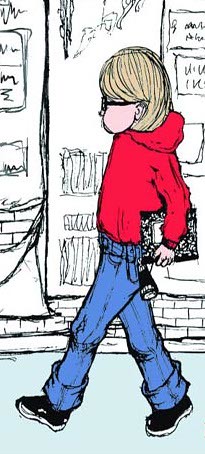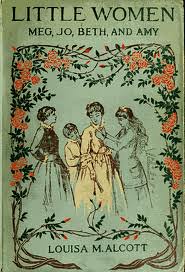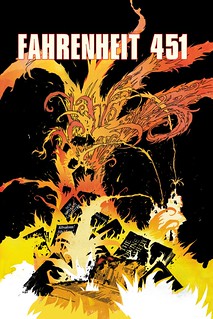So far this blog series has covered banned children’s books, however we at Special Collections thought it was important to note the many other genres of books that are censored and banned every year, including young adult novels. Our exhibit features a case of young adult novels, from our collections, that have faced harsh criticisms since their publications. This case houses Harriet the Spy by Louise Fitzhugh, Little Women by Louisa May Alcott, Fahrenheit 451 by Ray Bradbury, and The Outsiders by Tulsa’s own S.E. Hinton.
 Harriet the Spy, like many of the other books showcased in this exhibit, is so popular that in 1996 it was adapted into a film under the same title. Young girls growing up in the 90s would have read the book and seen the movie and therefore known the character very well. And young readers loved Harriet when her book first hit the shelves in 1964. “In the 1960s and 70s young girls formed Harriet the Spy clubs where they dressed liked the character and would spy on their parents and friends” (npr.org). Yet regardless of the novel’s and movie’s popularity the book was banned and challenged by many parents and teachers who thought Harriet served as a poor role model for young girls. According to an NPR story titled “Unapologetically Harriet, The Misfit Spy”, critics of the novel argued that Harriet “exhibited delinquent tendencies” and furthermore the critics stated “Harriet didn’t spy, but rather gossiped, slandered, and hurt other people without feeling sorry about her actions”. In fact in the 1980s in Ohio the book was banned from public school systems based on the argument that Harriet taught young children to lie, spy, back-talk, and curse. All of these behaviors and character attributes were considered unsavory for young readers. Unlike Nancy Drew, Harriet symbolized a young girl taking independent action to achieve her goals and “tomboy” behavior which was deemed vulgar in the minds of mid-twentieth century parents. It seems that these parents had their own standards of childhood femininity, and Harriet was breaking those social norms and received backlash because of it.
Harriet the Spy, like many of the other books showcased in this exhibit, is so popular that in 1996 it was adapted into a film under the same title. Young girls growing up in the 90s would have read the book and seen the movie and therefore known the character very well. And young readers loved Harriet when her book first hit the shelves in 1964. “In the 1960s and 70s young girls formed Harriet the Spy clubs where they dressed liked the character and would spy on their parents and friends” (npr.org). Yet regardless of the novel’s and movie’s popularity the book was banned and challenged by many parents and teachers who thought Harriet served as a poor role model for young girls. According to an NPR story titled “Unapologetically Harriet, The Misfit Spy”, critics of the novel argued that Harriet “exhibited delinquent tendencies” and furthermore the critics stated “Harriet didn’t spy, but rather gossiped, slandered, and hurt other people without feeling sorry about her actions”. In fact in the 1980s in Ohio the book was banned from public school systems based on the argument that Harriet taught young children to lie, spy, back-talk, and curse. All of these behaviors and character attributes were considered unsavory for young readers. Unlike Nancy Drew, Harriet symbolized a young girl taking independent action to achieve her goals and “tomboy” behavior which was deemed vulgar in the minds of mid-twentieth century parents. It seems that these parents had their own standards of childhood femininity, and Harriet was breaking those social norms and received backlash because of it.
 Little Women by Louisa May Alcott, published in 1868, came almost 100 years before Harriet the Spy and also received harsh criticisms on how Alcott chose to represent her lead character Jo March. “Alcott was both an abolitionist and a feminist. She was a supporter of women’s suffrage and the first woman to register to vote in Concord Massachusetts” (bannedbooks.world.edu). Alcott’s feminist ideals play heavily in the
Little Women by Louisa May Alcott, published in 1868, came almost 100 years before Harriet the Spy and also received harsh criticisms on how Alcott chose to represent her lead character Jo March. “Alcott was both an abolitionist and a feminist. She was a supporter of women’s suffrage and the first woman to register to vote in Concord Massachusetts” (bannedbooks.world.edu). Alcott’s feminist ideals play heavily in the  representation of Jo March. Jo is considered one of the sassiest and smartest female characters in American literature. It should come as no surprise that immediately following the book’s publication it received backlash from Alcott’s male colleagues. However, what is more shocking is the fact that “modern-day feminists have challenged the novel for its portrayal of traditional gender roles- specifically, the role of women in the home” (bannedbooks.world.edu). Feminist groups argue that Little Women “diminishes young women, panders to the ‘weaker sex’ mentality, and fails to empower girls to succeed”. The point of argument focuses on the conclusion of the novel where our heroine ends up married to an older man. The challenges against Little Women create a paradox for in its own time it was considered too radical for insinuating that women could freely choose what they wanted out of life, yet today critics argue that the radicalism did not go far enough.
representation of Jo March. Jo is considered one of the sassiest and smartest female characters in American literature. It should come as no surprise that immediately following the book’s publication it received backlash from Alcott’s male colleagues. However, what is more shocking is the fact that “modern-day feminists have challenged the novel for its portrayal of traditional gender roles- specifically, the role of women in the home” (bannedbooks.world.edu). Feminist groups argue that Little Women “diminishes young women, panders to the ‘weaker sex’ mentality, and fails to empower girls to succeed”. The point of argument focuses on the conclusion of the novel where our heroine ends up married to an older man. The challenges against Little Women create a paradox for in its own time it was considered too radical for insinuating that women could freely choose what they wanted out of life, yet today critics argue that the radicalism did not go far enough.
 Fahrenheit 451 by Ray Bradbury “presents a future American society where books are outlawed and ‘firemen’ burn any that are found. The title refers to the temperature that Bradbury understood to be the ignition point of paper” (Wikipedia). It is very ironic that a book about banning books has been challenged and banned so many times since its publication in 1953. In fact, the novel has been banned so frequently that it maintains a steady spot on the American Library Association’s top 100 banned books list. For example, in 1998 Bradbury’s novel was removed from the required reading list of a High School in Mississippi. A parent complained that the book should be removed because its use of the words “God Damn”. After the complaint was filed the superintendent of the public school system forced the teachers at West Marion High School to remove the book from the reading list and any future reading assignments. The book has also been cited for portraying “questionable themes” that aren’t suitable for young readers. The main theme in the story is opposition to any government which tries to suppress freedom of expression. When the book was originally published, advocacy for opposition against the government was seen as evil. Therefore, many parents and school administrators forced the removal of the novel from reading list and library shelves. To this day Fahrenheit 451 is viewed as controversial and is still banned in many rural school systems in the United States.
Fahrenheit 451 by Ray Bradbury “presents a future American society where books are outlawed and ‘firemen’ burn any that are found. The title refers to the temperature that Bradbury understood to be the ignition point of paper” (Wikipedia). It is very ironic that a book about banning books has been challenged and banned so many times since its publication in 1953. In fact, the novel has been banned so frequently that it maintains a steady spot on the American Library Association’s top 100 banned books list. For example, in 1998 Bradbury’s novel was removed from the required reading list of a High School in Mississippi. A parent complained that the book should be removed because its use of the words “God Damn”. After the complaint was filed the superintendent of the public school system forced the teachers at West Marion High School to remove the book from the reading list and any future reading assignments. The book has also been cited for portraying “questionable themes” that aren’t suitable for young readers. The main theme in the story is opposition to any government which tries to suppress freedom of expression. When the book was originally published, advocacy for opposition against the government was seen as evil. Therefore, many parents and school administrators forced the removal of the novel from reading list and library shelves. To this day Fahrenheit 451 is viewed as controversial and is still banned in many rural school systems in the United States.
 S.E. Hinton’s book The Outsiders has also been challenged and banned for its alleged depiction of controversial and “ungodly” themes. Hinton wrote the novel, set in Tulsa Oklahoma in the 1960s, when she was only 16 years old and it was published when Hinton reached the young age of 18. The novel follows two rival groups, the Greasers and the Socs, who are divided by their socioeconomic status. The novel was adapted into a film version in 1983 and into a short lived television series in 1990. Unfortunately the novel’s popularity could not shield it from the criticisms of religious groups. Churches throughout the United States have made public statements arguing that the novel should be kept away from young readers. The religious officials argued that the novel depicts drugs, violence, sex, and the results of falling from the Christian path. In 1986 the book was challenged in Milwaukee Wisconsin for its inclusion on an eighth grade reading list. The parents involved in the complaint against the book argued that the book should be removed because “drug and alcohol abuse was common and virtually all the characters are from broken homes”. Hinton’s novel currently sits at #43 on the American Library Association’s banned list; the book is most commonly banned for its depiction of gangs and gang violence. The most recent challenge against the book took place in 2001 at a middle school in West Virginia due to objections against the gang violence depicted in the story. “The book was written about teenagers by a teenager, and parents generally objected, claiming that their children are being exposed to things they aren’t prepared for and insist schools pull it from their curriculums” (bannedbooks.world.edu). Parents have also argued that the book does not include enough positive role models.
S.E. Hinton’s book The Outsiders has also been challenged and banned for its alleged depiction of controversial and “ungodly” themes. Hinton wrote the novel, set in Tulsa Oklahoma in the 1960s, when she was only 16 years old and it was published when Hinton reached the young age of 18. The novel follows two rival groups, the Greasers and the Socs, who are divided by their socioeconomic status. The novel was adapted into a film version in 1983 and into a short lived television series in 1990. Unfortunately the novel’s popularity could not shield it from the criticisms of religious groups. Churches throughout the United States have made public statements arguing that the novel should be kept away from young readers. The religious officials argued that the novel depicts drugs, violence, sex, and the results of falling from the Christian path. In 1986 the book was challenged in Milwaukee Wisconsin for its inclusion on an eighth grade reading list. The parents involved in the complaint against the book argued that the book should be removed because “drug and alcohol abuse was common and virtually all the characters are from broken homes”. Hinton’s novel currently sits at #43 on the American Library Association’s banned list; the book is most commonly banned for its depiction of gangs and gang violence. The most recent challenge against the book took place in 2001 at a middle school in West Virginia due to objections against the gang violence depicted in the story. “The book was written about teenagers by a teenager, and parents generally objected, claiming that their children are being exposed to things they aren’t prepared for and insist schools pull it from their curriculums” (bannedbooks.world.edu). Parents have also argued that the book does not include enough positive role models.
All the works featured in this exhibit have faced harsh criticisms. However, book censorship should always be questioned. It is up to the reader and the parent to choose if a novel is suitable to be read. Yet books teach us many things, they introduce us to real world scenarios that we might not approach in our day to day lives. Because of this it is important for the world of literature to be easily accessible to all people.
Due to popular demand the exhibit Banned Children’s Books will remain on display until the second week of April. Don’t miss your chance to visit and learn more about our favorite childhood stories that have been banned and challenged throughout their literary lives. You can visit the exhibit at Special Collection located on the 5th floor of McFarlin library. The department is open Monday-Friday 8-5.
